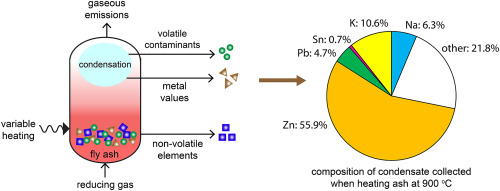Journal of Cleaner Production ( IF 9.7 ) Pub Date : 2020-01-11 , DOI: 10.1016/j.jclepro.2020.120014 Daniel J. Lane , Aki Hartikainen , Olli Sippula , Anna Lähde , Arunas Mesceriakovas , Sirpa Peräniemi , Jorma Jokiniemi

|
Municipal solid waste incineration fly ashes can contain high concentrations of Zn and other valuable elements including Cu, Pb, Sn, and Sb. These elements can potentially be separated from fly ashes by selectively volatilising and condensing them in thermal processes. This study presents a thermal process for production of zinc concentrates from fly ashes and assesses the impact of the reducing gas atmosphere used in the process on the volatility of Zn, Pb, and Cu. Concentrates were produced by heating samples of municipal solid waste incineration fly ash in a reducing atmosphere, consisting of 10% H2 and 90% N2, and selectively condensing elements which volatilised from the ash at 900 and 1100 °C. Thermodynamic equilibrium calculations were used to predict the volatile behaviour of Zn, Pb, and Cu in the reducing atmosphere and in an oxidising atmosphere (air). The extent of volatilisation of these elements was also determined experimentally for both the reducing atmosphere and the oxidising atmosphere by means of mass balances based on elemental analyses of untreated and heat-treated ashes. The concentrate produced at 900 °C contained high concentrations of Zn (55.9 ± 12.5% w/w) and Pb (4.7 ± 1.1% w/w). These metals and other higher value elements, specifically, Sn, Sb, and Bi, were greatly enriched in the concentrates when compared with the untreated fly ash, showing a high potential for the developed process to separate multiple valuable elements from ashes. However, several deleterious impurities, particularly K, Na, and Cd, also reported to the concentrates in significant concentrations. Further refinements to the process are needed to separate these elements from Zn. The reducing gas atmosphere substantially increased the volatility of Zn, but suppressed the volatility of Cu and, to a lesser extent, the volatility of Pb. The equilibrium calculations overestimated the release of Cu in oxidising conditions and the release of Zn and Pb in both oxidising and reducing conditions.
中文翻译:

从城市固体垃圾焚烧飞灰中热分离锌和其他有价值的元素
城市固体废物焚烧飞灰可能包含高浓度的锌和其他有价值的元素,包括铜,铅,锡和锑。通过在热处理过程中选择性地挥发和冷凝这些元素,可以将它们与飞灰分离。这项研究提出了一种利用粉煤灰生产锌精矿的热过程,并评估了该过程中使用的还原性气体气氛对Zn,Pb和Cu挥发性的影响。通过在还原性气氛中加热城市固体垃圾焚烧飞灰的样品来生产浓缩液,其中包括10%H 2和90%N 2,并选择性地冷凝在900和1100°C下从灰烬中挥发出来的元素。使用热力学平衡计算来预测Zn,Pb和Cu在还原性气氛和氧化性气氛(空气)中的挥发行为。还基于未处理和热处理的骨灰的元素分析,通过质量平衡,通过实验确定了还原性气氛和氧化性气氛中这些元素的挥发程度。在900°C下生产的精矿含有高浓度的Zn(55.9±12.5%w / w)和Pb(4.7±1.1%w / w)。与未处理的粉煤灰相比,这些金属和其他高价值元素(特别是Sn,Sb和Bi)在精矿中大大富集,对已开发的工艺从灰烬中分离出多种有价值的元素显示出很高的潜力。然而,也向浓缩物中报告了几种有害杂质,特别是钾,钠和镉,浓度很高。需要进一步改进工艺以将这些元素与Zn分离。还原性气体气氛实质上增加了Zn的挥发性,但是抑制了Cu的挥发性,并且在较小程度上抑制了Pb的挥发性。平衡计算高估了氧化条件下Cu的释放以及氧化条件和还原条件下Zn和Pb的释放。还原性气体气氛实质上增加了Zn的挥发性,但是抑制了Cu的挥发性,并且在较小程度上抑制了Pb的挥发性。平衡计算高估了氧化条件下Cu的释放以及氧化条件和还原条件下Zn和Pb的释放。还原性气体气氛实质上增加了Zn的挥发性,但是抑制了Cu的挥发性,并且在较小程度上抑制了Pb的挥发性。平衡计算高估了氧化条件下Cu的释放以及氧化条件和还原条件下Zn和Pb的释放。











































 京公网安备 11010802027423号
京公网安备 11010802027423号